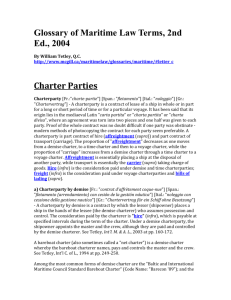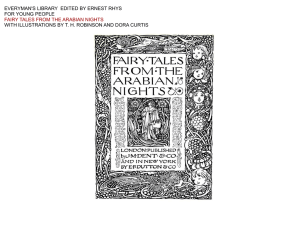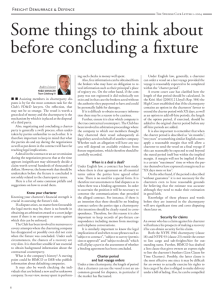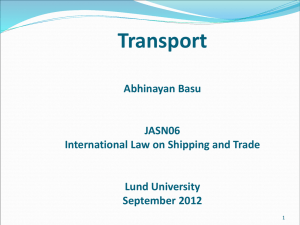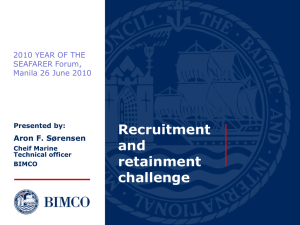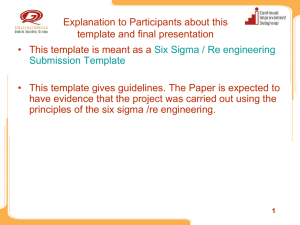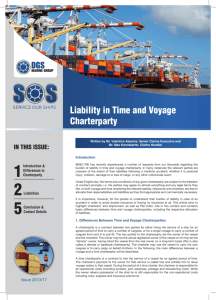Material and Lectures Relating to Charterparties
advertisement
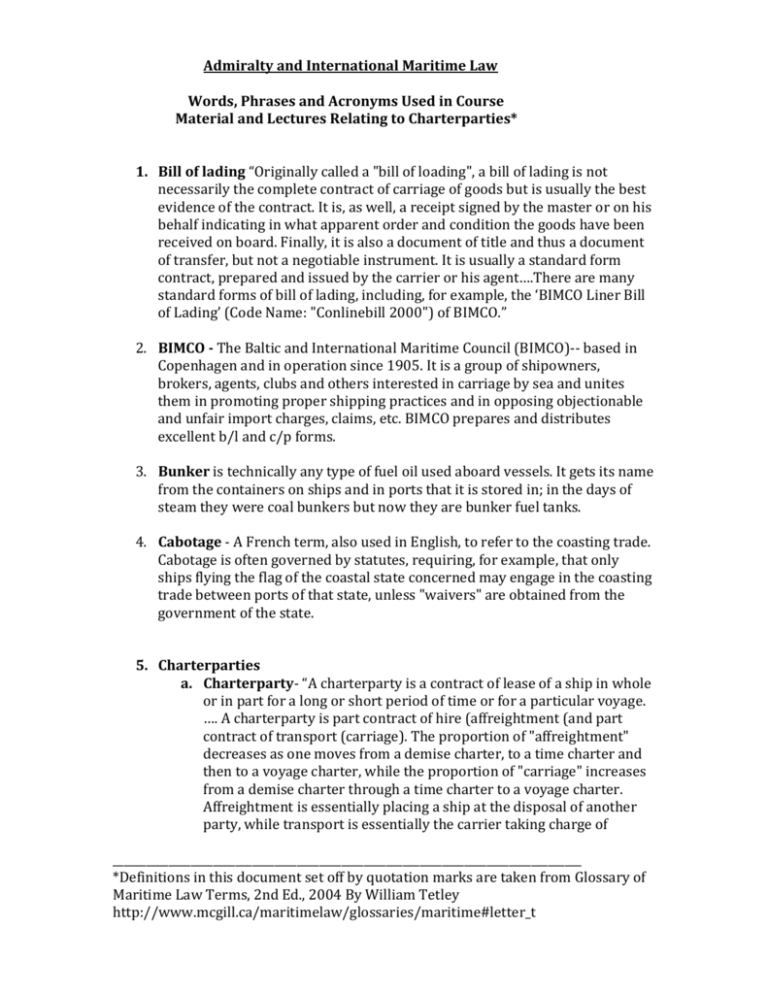
Admiralty and International Maritime Law Words, Phrases and Acronyms Used in Course Material and Lectures Relating to Charterparties* 1. Bill of lading “Originally called a "bill of loading", a bill of lading is not necessarily the complete contract of carriage of goods but is usually the best evidence of the contract. It is, as well, a receipt signed by the master or on his behalf indicating in what apparent order and condition the goods have been received on board. Finally, it is also a document of title and thus a document of transfer, but not a negotiable instrument. It is usually a standard form contract, prepared and issued by the carrier or his agent….There are many standard forms of bill of lading, including, for example, the ‘BIMCO Liner Bill of Lading’ (Code Name: "Conlinebill 2000") of BIMCO.” 2. BIMCO - The Baltic and International Maritime Council (BIMCO)-- based in Copenhagen and in operation since 1905. It is a group of shipowners, brokers, agents, clubs and others interested in carriage by sea and unites them in promoting proper shipping practices and in opposing objectionable and unfair import charges, claims, etc. BIMCO prepares and distributes excellent b/l and c/p forms. 3. Bunker is technically any type of fuel oil used aboard vessels. It gets its name from the containers on ships and in ports that it is stored in; in the days of steam they were coal bunkers but now they are bunker fuel tanks. 4. Cabotage - A French term, also used in English, to refer to the coasting trade. Cabotage is often governed by statutes, requiring, for example, that only ships flying the flag of the coastal state concerned may engage in the coasting trade between ports of that state, unless "waivers" are obtained from the government of the state. 5. Charterparties a. Charterparty- “A charterparty is a contract of lease of a ship in whole or in part for a long or short period of time or for a particular voyage. …. A charterparty is part contract of hire (affreightment (and part contract of transport (carriage). The proportion of "affreightment" decreases as one moves from a demise charter, to a time charter and then to a voyage charter, while the proportion of "carriage" increases from a demise charter through a time charter to a voyage charter. Affreightment is essentially placing a ship at the disposal of another party, while transport is essentially the carrier taking charge of ____________________________________________________________________________________ *Definitions in this document set off by quotation marks are taken from Glossary of Maritime Law Terms, 2nd Ed., 2004 By William Tetley http://www.mcgill.ca/maritimelaw/glossaries/maritime#letter_t goods. Hire (is the consideration paid under demise and time charterparties; freight is the consideration paid under voyage charterparties and bills of lading.” b. Voyage charterparty –“A voyage charterparty is a contract whereby the lessor (the shipowner or demise or time charterer) places all or part of the carrying capacity of a ship at the disposal of the lessee (the voyage charterer) for the transport of goods agreed upon, on one or more voyages, for a consideration called "freight" (infra), based on the quantity of cargo carried and is payable as provided for in the charterparty. Among the most commonly used forms of voyage charterparty are the "Asbatankvoy" form of tanker charter of the Association of Ship Brokers and Agents (U.S.A.) Inc., and the "Baltic and International Maritime Council Uniform General Charter (As Revised 1922, 1976 and 1994)" (Code Name: "Gencon") form of BIMCO.” c. Time charterparty –“A time charterparty is a contract whereby the lessor (the shipowner or demise charterer) places a fully equipped and manned ship at the disposal of the lessee (the time charterer) for a period of time for a consideration called "hire"… payable at specified intervals during the term of the charter. Among the most common forms of time charterparty are the New York Produce Exchange (NYPE) and NYPE '93 forms, issued by the Association of Ship Brokers and Agents (U.S.A.) Inc., the "BIMCO Uniform TimeCharter (As Revised 2001)" (Code Name: "Baltime 1939") form of BIMCO and SHELLTIME.” d. Charterparty by demise is “a contract by which the lessor (shipowner) places a ship in the hands of the lessee (the demise charterer) who assumes possession and control. The consideration paid by the charterer is "hire"…which is payable at specified intervals during the term of the charter. Under a demise charterparty, the shipowner appoints the master and the crew, although they are paid and controlled by the demise charterer…. i. “A bareboat charter (also sometimes called a "net charter") is a demise charter whereby the bareboat charterer names, pays and controls the master and the crew… ii. “Among the most common forms of demise charter are the "Baltic and International Maritime Standard Bareboat Charter" (Code Name: "Barecon '89"); and the "BIMCO Standard Charter" (Code Name: "Barecon 2001") forms of BIMCO and the SHELLDEMISE form of demise charterparty.” 6. Classification societies- “Classification societies are institutions (often nonprofit) which inspect, study and report on the seaworthiness and the general and particular condition of individual ships. They also often perform port state control inspections. Finally, they may provide surveying services to national maritime administrations by contract with the governments of those countries. They issue a certificate of “class” of the ship.” 7. The leading societies and members of the International Association of Classification Societies (IACS) are: a. American Bureau of Shipping (ABS); b. Det Norske Veritas (DNV); c. Germanischer Lloyd (GL); d. Lloyd’s Register (LR); e. Bureau Veritas (BV). 8. Consignee- The party to whom delivery of the goods is to be made under a contract for the carriage of goods by water, land or air. 9. Consignor- in a contract of carriage, is the person sending a shipment to be delivered whether by land, sea or air. Some carriers, such as national postal entities, use the term "sender" or "shipper" but in the event of a legal dispute the proper and technical term "consignor" will generally be used. 10. Dunnage – “Material (usually lumber) used to secure cargo in containers and ships' holds in order to prevent shifting and resulting damage during the voyage.” 11. Freight is "the remuneration payable for the carriage by the vessel of property or passengers or for the use of the vessel". I.e., “the consideration for the carriage of goods under bills of lading,…sea waybills…,and voyage charterparties….” 12. Hire is “the consideration in bareboat, demise and time charterparties.” 13. Terms Used Only in Voyage Charterparties a. Laytime –“In a voyage charterparty…, the period of time (the "lay days") agreed between the parties during which the shipowner will make and keep the vessel available to the voyage charterer for loading or discharging without payment additional to the freight.” b. Demurrage – “In a voyage charterparty …, an agreed amount payable to the shipowner by the charterer in respect of delay in loading or discharging the vessel beyond the laytime …, for which the owner is not responsible.” 14. Tons and Tonnage a. Short ton (American) 2000 lbs. Long ton (English) 2240 lbs. Metric ton (1000 kg.) 2204.6 lbs. b. Gross tonnage (GT)– “the actual carrying capacity of the ship's hull below the upper deck, in cubic feet, divided by 100” c. Net tonnage (NT) - the gross tonnage less the number of cubic feet reserved for crew's quarters, ships stores, bunkers, engine room space, etc.” d. Deadweight cargo capacity--In a voyage charterparty, the vessel's deadweight tonnage, from which bunkers, fresh water and "constant" (e.g. galley supplies, paint, lubricating, oil, etc.) are deducted, to determine the ship's actual cargo carrying capacity. e. Deadweight tonnage “is the actual cargo carrying capacity of the ship, when she is fully loaded with cargo so that the hull is immersed in water up to her Plimsoll marks.” “Plimsoll line (Plimsoll mark) - A mark painted on the side of merchant vessels showing the various draught levels to which the ship may be loaded, usually including tropical fresh water, fresh water, tropical sea water, summer sea water, winter sea water and (for vessels under 100 meters in length) winter North Atlantic Ocean water. The Plimsoll line is accompanied by a circle bisected by a horizontal line, indicating the summer freeboard of the ship and letters signifying the name of the ship's classification society (e.g. Lloyd's Register). The Plimsoll line is named for Samuel Plimsoll (1824-1898), an English Member of Parliament who fought for improved safety of British merchant ships.” f. Register tonnage “is the gross tonnage and/or the net tonnage, as entered on a ship's certificate of registry. A register ton is 100 cu. ft.” 15. Types of Vessels a. Liner - A vessel habitually employed on a regular schedule and loading and discharging at specified ports. b. Tramp – A vessel is one which does not have a fixed schedule or published ports of call. As opposed to freight liners, tramp ships trade on the spot market with no fixed schedule or itinerary/ports-ofcall(s). A steamship engaged in the tramp trade is sometimes called a tramp steamer; the similar terms tramp freighter and tramper are also in use. The term is derived from the British meaning of "tramp" as itinerant beggar or vagrant; in this context it is first documented in the 1880s, along with "ocean tramp" (at the time many sailing vessels engaged in irregular trade as well). 16.
